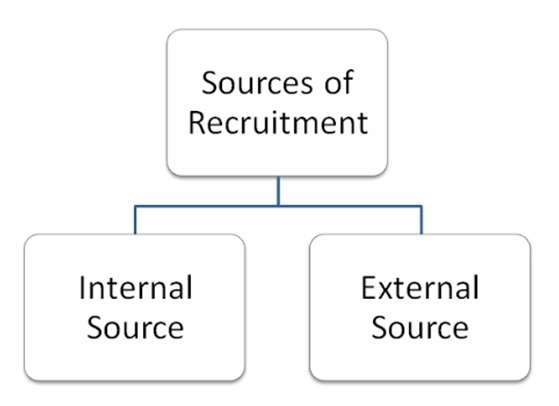
- Recruitment and Selection Tutorial
- Recruitment and Selection - Home
- Introduction
- What is Recruitment?
- Factors Affecting Recruitment
- Recruitment Process
- Types of Recruitment
- Recruitment Interviews
- Types of Interviews
- What is Selection?
- Salary Negotiations
- Making a Job Offer
- Recruitment & Selection Resources
- Quick Guide
- Useful Resources
- Discussion
Types of Recruitment
For any organization, recruitment is a crucial part of developing and maintaining an effective and efficient team. A good recruitment strategy will cut down the wastage of time and money, which would have incurred for extensive training and development of unqualified resources.
Have you ever thought of, how a recruiter finds the right candidates? Recruiters use different methods to source, screen, shortlist, and select the resources as per the requirements of the organization. Recruitment types explain the means by which an organization reaches potential job seekers.

In this chapter, we will shed some light on the secrets of hiring and recruiting methods, used by the recruiters. Recruitment is broadly classified into two different categories − Internal Sources and External Sources.
Internal Sources of Recruitment
Internal sources of recruitment refer to hiring employees within the organization internally. In other words, applicants seeking for the different positions are those who are currently employed with the same organization.
At the time recruitment of employees, the initial consideration should be given to those employees who are currently working within the organization. This is an important source of recruitment, which provides the opportunities for the development and utilization of the existing resources within the organization.
Internal sources of recruitment are the best and the easiest way of selecting resources as performance of their work is already known to the organization. Let us now discuss more on the various internal sources of recruitment.
Promotions
Promotion refers to upgrading the cadre of the employees by evaluating their performance in the organization. It is the process of shifting an employee from a lower position to a higher position with more responsibilities, remuneration, facilities, and status. Many organizations fill the higher vacant positions with the process of promotions, internally.
Transfers
Transfer refers to the process of interchanging from one job to another without any change in the rank and responsibilities. It can also be the shifting of employees from one department to another department or one location to another location, depending upon the requirement of the position.
Let’s take an example to understand how it works. Assume there is a finance company called ABC Ltd. Having two branches, Branch-A and Branch-B, and an employee from Branch-A resigned from his job responsibilities. Hence, this position has to be filled for the continuation of the project in Branch-A.
In this scenario, instead of searching or sourcing new candidates, which is time consuming and expensive, there is a possibility of shifting an employee from Branch-B to Branch-A, depending upon the project requirements and the capabilities of that respective employee. This internal shifting of an employee from one branch to another branch is called as Transfer.

Recruiting Former Employees
Recruiting former employees is a process of internal sources of recruitment, wherein the exemployees are called back depending upon the requirement of the position. This process is costeffective and saves plenty of time. The other major benefit of recruiting former employees is that they are very well versed with the roles and responsibilities of the job and the organization needs to spend less on their training and development.
Internal Advertisements (Job Posting)
Internal Advertisements is a process of posting/advertising jobs within the organization. This job posting is an open invitation to all the employees inside the organization, where they can apply for the vacant positions. It provides equal opportunities to all the employees working in the organization. Hence, the recruitment will be done from within the organization and it saves a lot of cost.
Employee Referrals
Employee referrals is an effective way of sourcing the right candidates at a low cost. It is the process of hiring new resources through the references of employees, who are currently working with the organization. In this process, the present employees can refer their friends and relatives for filling up the vacant positions.
Organizations encourage employee referrals, because it is cost effective and saves time as compared to hiring candidates from external sources. Most organizations, in order to motivate their employees, go ahead and reward them with a referral bonus for a successful hire.
Previous Applicants
Here, the hiring team checks the profiles of previous applicants from the organizational recruitment database. These applicants are those who have applied for jobs in the past. These resources can be easily approached and the response will be positive in most of the cases. It is also an inexpensive way of filling up the vacant positions.
Pros and Cons of Internal Sources of Recruitment
Internal sources of recruitment, i.e., hiring employees within the organization, has its own set of advantages and disadvantages. The advantages are as follows −
- It is simple, easy, quick, and cost effective.
- No need of induction and training, as the candidates already know their job and responsibilities.
- It motivates the employees to work hard, and increases the work relationship within the organization.
- It helps in developing employee loyalty towards the organization.
The drawbacks of hiring candidates through internal sources are as follows −
- It prevents new hiring of potential resources. Sometimes, new resources bring innovative ideas and new thinking onto the table.
- It has limited scope because all the vacant positions cannot be filled.
- There could be issues in between the employees, who are promoted and who are not.
- If an internal resource is promoted or transferred, then that position will remain vacant.
- Employees, who are not promoted, may end up being unhappy and demotivated.
External Sources of Recruitment
External sources of recruitment refer to hiring employees outside the organization externally. In other words, the applicants seeking job opportunities in this case are those who are external to the organization.
External employees bring innovativeness and fresh thoughts to the organization. Although hiring through external sources is a bit expensive and tough, it has tremendous potential of driving the organization forward in achieving its goals. Let us now discuss in detail the various external sources of recruitment.
Direct Recruitment
Direct recruitment refers to the external source of recruitment where the recruitment of qualified candidates are done by placing a notice of vacancy on the notice board in the organization. This method of sourcing is also called as factory gate recruitment, as the blue-collar and technical workers are hired through this process.
Employment Exchanges
As per the law, for certain job vacancies, it is mandatory that the organization provides details to the employment exchange. Employment exchange is a government entity, where the details of the job seekers are stored and given to the employers for filling the vacant positions. This external recruitment is helpful in hiring for unskilled, semi-skilled, and skilled workers.

Employment Agencies
Employment agencies are a good external source of recruitment. Employment agencies are run by various sectors like private, public, or government. It provides unskilled, semi-skilled and skilled resources as per the requirements of the organization. These agencies hold a database of qualified candidates and organizations can use their services at a cost.
Advertisements
Advertisements are the most popular and very much preferred source of external source of recruitment. The job vacancy is announced through various print and electronic media with a specific job description and specifications of the requirements. Using advertisements is the best way to source candidates in a short span and it offers an efficient way of screening the candidates’ specific requirements.
Let’s take an example. Assume that there is a Sales Company called XYZ Ltd which has got a new project of selling a product in a short span of time, as the competition is very high. In this scenario, choosing the specific recruitment plays a vital role. Here the ideal type of recruitment which should be chosen is Advertisement.
Advertisement is the best suitable practice for this kind of hiring, because a large volume of hiring in a short span can be done through Advertisement only. Advertisement is one of the costliest way to recruit candidates, but when time and number are important, then advertisement is the best source of recruitment.
Professional Associations
Professional associations can help an organization in hiring professional, technical, and managerial personnel, however they specialize in sourcing mid-level and top-level resources. There are many professional associations that act as a bridge between the organizations and the job-seekers.
Campus Recruitment
Campus recruitment is an external source of recruitment, where the educational institutions such as colleges and universities offers opportunities for hiring students. In this process, the organizations visit technical, management, and professional institutions for recruiting students directly for the new positions.
Word of Mouth Advertising
Word of mouth is an intangible way of sourcing the candidates for filling up the vacant positions. There are many reputed organizations with good image in the market. Such organizations only need a word-of-mouth advertising regarding a job vacancy to attract a large number of candidates.
Pros and Cons of External Sources of Recruitment
External sources of recruitment, i.e., hiring employees outside an organization, has both its benefits and drawbacks. The benefits are as follows −
- It encourages new opportunities for job seekers.
- Organization branding increases through external sources.
- There will be no biasing or partiality between the employees.
- The scope for selecting the right candidate is more, because of the large number candidates appearing.
The disadvantages of recruiting through external sources are as follows −
- This process consumes more time, as the selection process is very lengthy.
- The cost incurred is very high when compared to recruiting through internal sources.
- External candidates demand more remuneration and benefits.
To conclude, the HR department should be flexible enough to choose between internal or external methods of recruitment, depending upon the requirement of the organization.